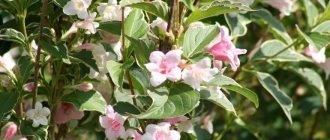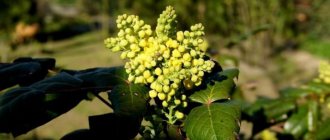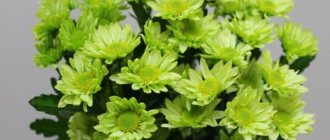Yellow chrysanthemums are incredibly beautiful and bright autumn flowers that can decorate any flowerbed until the first frost. They thrive in the climatic conditions of different regions of Russia, are ideal for growing as cut flowers, and compete with many ornamental crops. The plant is not particularly demanding; even a novice gardener can cope with planting and caring for it.
Yellow chrysanthemums often decorate floral arrangements and bouquets
Description of types and varieties of white chrysanthemums
There are countless types and varieties of white representatives of annual or perennial Asteraceae family.
Stalion, white chrysanthemum
Some of them:
- Chamomile. These include “Snegurochka”, “Chick”, “Himalayas”. They got their name due to their resemblance to chamomile: a large yellow core and white petals.
- Korean grandiflora. These are “Swan”, “Bear”, “Poodle” and others. They look very voluminous and majestic.
- Korean multiflora. They differ in that the edges of the petals become pink when flowering: “Furor”, “White”.
- Bush varieties: “Euro”, “Coconut”, “Sky” (if you rub the core of the inflorescence at the time of flowering, it will turn lemon yellow).
- Low-growing: “Bonita”, “Bride’s Attire”. They bloom in early autumn.
- Chrysanthemum White Anastasia. It belongs to the Indian variety and is distinguished by large flowers mixed with green.
Additional Information . A self-propelled anti-tank missile system is named after an elegant flower. “Chrysanthemum PTK” was created at the Kolomenskoye Design Bureau of Mechanical Engineering. In addition, the edible vegetable chrysanthemum, which is used in Chinese medicine, is widely popular among people. In Bulgaria, “Chrysanthemum” is a wonderful 4* hotel near the sea.
Bacardi
Chrysanthemum Bacardi is a very elegant delicate flower. It was first presented in 2004 at a performance by singer M. Borsato. Now Bacardi is often included in mixed bouquets of different types of flowers.
Bacardi yellow
There is not only white, but also yellow, cream, red, soft pink. It blooms already in July and blooms until the end of September. With its strong green stem it remains durable for a long time.
Santini
Chrysanthemum Santini is considered a mini chrysanthemum. This is a small-flowered variety - a small and compact bush. The inflorescences are double, chamomile-shaped and spherical. Up to 30 flowers can open on one bush.
Santini variety
A very frost-resistant species, but during wintering it needs shelter.
Multiflora
Chrysanthemum Multiflora planting and care is not difficult. Now this variety is presented in almost all catalogs of famous flower companies. Multiflora can be grown both in pots and in open ground.
Note ! It is difficult for a novice gardener to choose from a huge number of “autumn queens” those that will be easy to cope with at first. Beginning flower growers should pay attention to the Sabu chrysanthemum, “Umka”, “Monomakh’s Cap” (an extraordinary color gradient will be created by planting “Monomakh” with the Lipstick chrysanthemum), “Apple Blossom” and “Grand Pink”. “Saba” will surprise you with its colors, and “Grand Pink” will withstand various temperature fluctuations.
A special feature is that the crown is naturally formed in the form of a ball. This variety was bred to decorate gardens. After the Multiflora has fully bloomed, not even foliage can be seen through the flower ball. The height of the shrub does not exceed 40 cm, however, among the varieties there are also tall specimens.
Multiflora
Plants do not need to be pruned; only pinching is recommended. The disadvantage of Multiflora is considered to be poor frost resistance; it is not easy for it to winter in European countries.
Early varieties:
- Sunbeam Coral. Has coral flowers.
- Amor Dark Pink. The flowers have a pleasant pink color and reach 4 cm in diameter.
- Meridian Dar. Juicy, colorful, burgundy flowers are small in size, up to 3 cm in diameter.
Blooming in September:
- Branroyal Yellow. The shrub has yellow flowers and reaches a height of 70 cm.
- Branchili. Pleasant, soft cream color of flowers, about 4 cm in diameter, 40 cm in height.
Multiflora spherical
The chrysanthemum Multiflora globulus should be properly cared for:
- Choose a good place for planting, where there will definitely be sunlight. In its absence, the shape of the bush will be greatly distorted. Do not plant near fences, as then there will be no uniform lighting.
- Prepare the soil. In the autumn, you should add humus and ash, then carefully dig up the area. In the spring, dig again before planting. The optimal soil composition will be peat mixed with sand and turf soil.
Multiflora spherical
Reproduction occurs with the help of:
- Semyon,
- Shoots
- Cherenkov.
Wintering in open ground
Wintering in open ground is very risky for Multiflora, but for some gardeners this process is successful. To do this, you should build a good shelter yourself.
Important ! Even before the onset of the first frost, the bushes should be covered. It is important not to do this very early, as diaper rash may appear at the roots.
There should be no holes in the soil around the bush to prevent moisture from retaining in them. When there is a thaw, the soil will receive an excessive amount of moisture, which will cause the roots to die.
Before sheltering, the bush is trimmed so that it can fit under the canopy. The frame of the shelter is made of boards on which insulation is placed. The cover is removed in March-April, after the frosts have subsided.
Multiflora in Siberia
For Siberia, Multiflora is a rarity, since it is not able to withstand temperatures below seven degrees below zero. Even if it is covered, it will die under harsh conditions.
The only way out is to use the earliest varieties, which will fade by the first frost. Then they should be placed in the shelter in October and the wintering conditions should be constantly checked: whether the soil is drying out or, conversely, waterlogged, whether there is mold or mildew.
Caring for house flowers in winter
The flower pot is placed in a pantry or cellar, where the temperature does not rise above 5 degrees. At this time, the flower is not watered abundantly and is not fed at all. It is treated with antimicrobial agents.
With the onset of spring, the plant is exposed to the air, watering is increased, if the flower needs to be replanted, it is replanted, and in April they begin to feed it. And already in September, flowers will appear on the bushes again.
There are different shades of beautiful flowers; some like pink, some yellow, and some purple bush chrysanthemums. They are all beautiful in their own way and look very elegant.
Yellow chrysanthemums
White peonies - description and characteristics of the best varieties with a colored center
Yellow chrysanthemums are translated from Latin as “golden flowers”. Initially, the flower had an orange and golden color; later, with the help of selection, other shades began to appear.
Yellow chrysanthemums
The Chinese treat these flowers with respect because they believe they bring good luck. The effect, in their opinion, is enhanced if they are placed together with bamboo and pine. The Japanese call them "kiku" ("sun"). Kiku saves from illnesses, gives a charge of longevity and beauty.
In open ground they can take root with many crops:
- Plush,
- Cereals,
- Verest.
When creating a harmonious composition with a flower, you can even combine shrubs and fruit trees: apple tree, sea buckthorn and raspberry.
There are a lot of varieties of yellow chrysanthemum, they differ in the shape of inflorescences, leaves and color saturation.
Alice
This early variety is Multiflora. At the beginning of flowering, Alice is covered with orange-egg-colored flowers; as they fade, they become reddish.
Branarktis
Branarktis lemon reaches a height of 40 cm. Lemon inflorescences are up to 5 cm in diameter.
Branindio
Branindio is a lush shrub up to 50 cm in height.
What plants are combined with?
Yellow chrysanthemums, photos of whose flowers are presented in this review, go well with many ornamental crops. They are able to decorate city flower beds and garden plots, made in any style, with their inflorescences. They feel great next to sedum, ivy, cereals, heather, and astilbes. They can be used in single plantings, combined different subspecies in one flowerbed, and used to decorate multi-level compositions.
Yellow chrysanthemums are used to decorate lawns, open areas, and ponds. It is allowed to plant near shrubs, fruit trees, and conifers. The plant looks very impressive against the background of hydrangea and Chinese lemongrass.
Yellow chrysanthemums are excellent neighbors for all plant crops
In bouquets, these flowers are usually combined with roses, irises, and lilies. If you choose the right color palette, they will look beautiful in the same composition with carnations, alstroemeria, and gerbera.
Chrysanthemums chamomile
Yellow roses - description of popular varieties
Chamomile chrysanthemums first became known in Asia. They not only decorated gardens, but were also eaten.
Chamomile variety
These are perennial plants with umbrella-shaped inflorescences. Flowers are double and non-double. They are distinguished from field chamomile by their larger and more spectacular flower size.
There are different shades:
- Pink,
- Lilac,
- Red,
- yellow,
- Cream.
Additional Information . The chrysanthemum variety Maiden's inflorescences also resemble chamomile. This is one of the most compact chrysanthemums that can be grown at home.
Inga
Inga Chrysanthemum is a Korean variety. Shrub, up to 70 cm in height. The flowers are yellow in color, with tubular-shaped petals and feathery edges.
Camilla
Camille Chrysanthemum is a double bush. Inflorescences with a bright yellow core reach 5 cm in diameter. Very similar to chamomile. It lasts about 6 days after cutting.
Lacemaker
Chrysanthemum Crugevnica is an unusual Korean variety. Non-double, with petals that resemble the shape of a spoon. Convex yellow core. It blooms in October, the shrub rises in height by 55-70 cm.
Prosecco
Chrysanthemum Prosseco – bouquet bush. The flowers are small, the petals have a milky shade, the core is greenish in color, up to 6 cm in diameter. If you cut it, it can last for 2 weeks.
Zembla
Chrysanthemum Zembla is considered a large-flowered double beauty. It is cultivated as a bush and single-headed plant. You can decorate your garden, landscape design, and homely atmosphere with Zembla.
Zembla
In the garden it can reach a meter in height, at home - about 30 cm. The petals of the flower are shaped like a tongue, and there are up to 3-4 buds on one branch. The most popular are the yellow inflorescences.
Additional Information . The single-headed chrysanthemum also includes Magnum chrysanthemum, “Gagarin”, “Peter”, “Momoko” and the Baltic chrysanthemum. They are ideal for cutting, can last up to three weeks, and also tolerate cold very easily without moisture.
The word “mix” is often added to the name Zembla, since it has a huge variety of varieties, differing in the color of the petals.
Chrysanthemum keeled
Chrysanthemum keeled belongs to the group of annual chrysanthemums, which also includes crowned, sowing and multi-stemmed species.
Keeled tricolor
Has characteristic features:
- The leaves are arranged alternately
- The fruits are in the form of an achene with a fly,
- Inflorescences in the form of a basket up to 4 cm in diameter,
- Flowering begins in June and continues until the end of August.
Application in landscape design
These are plants with very versatile uses, with different varieties enjoying growing popularity.
Chrysanthemums can be used as follows:
- in garden beds;
- in containers on terraces, balconies;
- like cut flowers for vases.
Chrysanthemums will help maintain the elegant, decorative appearance of a flower bed until winter comes. On an autumn morning, when the first frosts have passed, flowering plants, the petals of which are covered with ice crystals or drops of dew showering the flowers, will add a special charm to the garden.
Blue chrysanthemums
Tamarix shrub - description of species and varieties
There is great interest in blue chrysanthemums among both gardeners and scientists. With the help of selection, it was possible to develop chrysanthemums of cream, purple, white, and green colors. Blue ones can only be obtained at the moment thanks to proper planting and care.
Variety of blue
The inflorescences acquire this unusual color after spraying or using food coloring.
Additional Information. However, before you receive such extraordinary flowers, you should take care of the right place for planting and proper careful care. The autumn queen chrysanthemum loves light and moisture; the soil should be constantly loosened so that it drains water well.
White, creamy beige specimens are suitable for coloring. Before coloring, prepare a jar, blue or blue food coloring, water and cut flowers.
Scheme:
- A neat cut is made on the stem of the bush. You can't damage it.
- According to the instructions, dye is diluted in water, where cut flowers are placed.
- The dyeing process takes from 8 to 20 hours.
Sowing seeds for seedlings
The flower is grown in small boxes with a low side. A drainage layer of expanded clay or small brick is laid below. It is recommended to sift the soil, consisting of equal parts of earth, peat and humus, and warm it up at 1300 C. When it cools down, pour it over the drainage.
The seeds of the perennial garden chrysanthemum plant are pressed shallowly into the soil, and the seeds of the annual plant are sprinkled with 0.5 cm of substrate. Then moisten with heated water and cover with film.
Can be placed in an unlit room with a temperature of 22-250 C. Ventilate periodically and do not allow the soil to dry out.
Half a month after the seedlings have pecked, the box is placed in a lighted spot and the film is removed. The cover is not removed immediately, allowing the plants to get used to the surrounding atmosphere: the first day for an hour, then adding more time every day.
Green chrysanthemums
Very rare and original look. The varieties are classified as single-headed and bush varieties.
Green beauties will add unprecedented beauty to bouquet compositions with roses, gerberas, asters and daffodils. As a rule, they are often chosen as gifts for successful men.
There are not many varieties of green queens. The color can be light green or deep, almost turquoise.
Code Green
Сhrysanthemum Code Green was bred by Dutch breeders and has malachite-colored pompom inflorescences. The bush will grow up to 70 cm in height and can last up to 3 weeks when cut.
Green Lizard
Full name: Chrysanthemum Green Lizard. Also bred in Holland.
Feeling Green
Flowers are up to 7 cm in diameter, light green in color. The height of the shrub can reach one and a half meters. Keeps very well after cutting.
Rhythm
Сhrysanthemum Rhythm has extraordinary needle-shaped inflorescences. The flowers reach a diameter of 7-9 cm, the petals “lighten” the core due to their delicate grass color. The height of the bush varies from 60 to 90 cm. This variety easily tolerates cold and transportation, maintaining its natural, original appearance after cutting.
Froggy
Froggy Green stands out with small ball-shaped inflorescences up to 4 cm in diameter. Froggies are often used to create harmonious floral compositions. Blooms in October.
You can look at three things for an infinitely long time: fire, water and... chrysanthemums. They combine simplicity, pride, joy, and beauty. The meaning of beautiful sunny beauties is to bring inspiration during the autumn blues, to protect the beauty of the garden in winter and to look forward to spring.
Sowing seeds
By the end of spring, when the cold weather ends, depressions are made in the area, moistened with heated water and a few seeds are thrown in. Fill the planting holes with soil and cover with greenhouse film. The distance between future bushes should be kept about 25 cm.
After emergence: remove the film, loosen the soil, weed the weeds, and fertilize after 1-2 weeks. Fertilize with a weak solution of “Ideal” or “Rainbow”.
When the seedlings grow to 7-10 cm, they are thinned out - leaving one strong plant. Removed seedlings can be distributed to neighbors or planted in another place.
Diseases, pests
With dense, unkempt plant thickets, fungal diseases may appear: Powdery mildew, Verticillium wilt, Rust.
Sometimes viral diseases affect: Aspermia, Dwarfism, Mosaic. The diseases are incurable and it is better to get rid of the affected plant.
The most malicious pests: nematodes, aphids, meadow bugs, as well as snails and slugs.
To prevent such misfortunes, you need to monitor the plant, care for it, adhering to the rules, inspect the bushes, do not allow harmful insects to attack the flowers, and use only sterile instruments for dividing. Carry out prevention during replanting of bushes or after digging.
Love the plant, care for it, follow the growing rules, and the chrysanthemum will respond to you with healthy, lush blooms that will delight you for many years.
Watering, fertilizing, replanting
Water the chrysanthemum generously and regularly with settled water, ideally rainwater. By adding 1-2 drops of ammonia per liter, you will fertilize the water. It is necessary to water right up to the root without touching the leaves. Then loosen the soil and remove weeds.
The bushes are systematically fertilized - at least 3-4 times per season. During development, ammonia nitrogen is needed to enlarge and strengthen the green part. To improve flowering, feed with potassium and phosphorus when the buds appear.
The liquid substrate is poured under the root a day after watering. The first feeding is done one and a half months after planting the seedlings in an open area. Bird droppings or burnt cow manure are used as organic matter.
After 3 years, the chrysanthemum needs to be replanted. Otherwise, she will weaken and begin to hurt. This procedure is carried out simultaneously with dividing the bush.
Temporary shelter arrangement
As an option for a protection device, temporary fences can be made. Its essence is to build walls and shelter on top. The walls can be made from bricks, stones, boxes or wooden pallets.
The manufacturing process is as follows. The trimmed and processed bush is hilled and mulched with loose material (leaves, shavings, pine needles). Then temporary walls are erected around a bush or a row of plants, and the entire structure is covered with slate, boards or film on top. The main thing is to ensure ventilation of the structure to avoid damping out.
Propagation by cuttings
In the spring, when the air warms up to 20-250 C, cut cuttings from a large bush with a sterilized knife. The stems are cut from the root, not the side, a few mm above the leaf bud. The cuttings are chosen 60-70 cm long.
You can use cuttings from a bouquet in a vase. Break the side shoot with the “heel”; if there is a flower, get rid of it.
After cutting or breaking a branch, keep it in a weak solution of manganese for 15 minutes and place it in Kornevin’s solution. The cuttings from the bouquet remain in Kornevin until the roots appear. Plant cuttings from the bush in nutritious soil or perlite.
When rooting, the plant should be in a well-lit place with a temperature of 15-180C. If the conditions are met, roots will appear by the end of the month. When the roots grow 1-2 cm, for subsequent cultivation, the cuttings are transplanted to an open lawn and covered until they gain strength.
How to store?
Some do not replant chrysanthemums for the winter, but leave them in the garden, while others leave such plants in a pot. Both options are valid and possible. Everything will depend on several factors:
What are the winters like in your region? If they are cold, then the soil layer probably freezes quite deeply. Due to low temperatures, the root system may die, so in this case it is better not to risk it and take the plants home
Where is your site located? The first thing you should pay attention to is whether the garden is protected from the winds. Although, if properly covered, gusts will not damage the shoots, they will still lower the temperature
In addition, a strong wind can destroy the shelter, and then the chrysanthemums will freeze. The second important point is the terrain of the site. If it is located in a lowland, then with the onset of spring and during a thaw, water will accumulate in the beds, and this can lead to debate and death of the shoots. So the area (especially flower beds) should be level. What variety are your chrysanthemums? They differ: while some can easily tolerate even frosts, others can only withstand mild European winters, and die when the temperature drops significantly. The most frost-resistant are Korean hybrids, which are collectively called “Oak”. This group includes a lot of varieties of different colors and sizes, but they all tolerate even cold winters well. If you are not very knowledgeable, then be especially careful when purchasing, since garden chrysanthemums can easily be confused with capricious and heat-loving house chrysanthemums. But the latter have larger leaves and large lush flowers.











